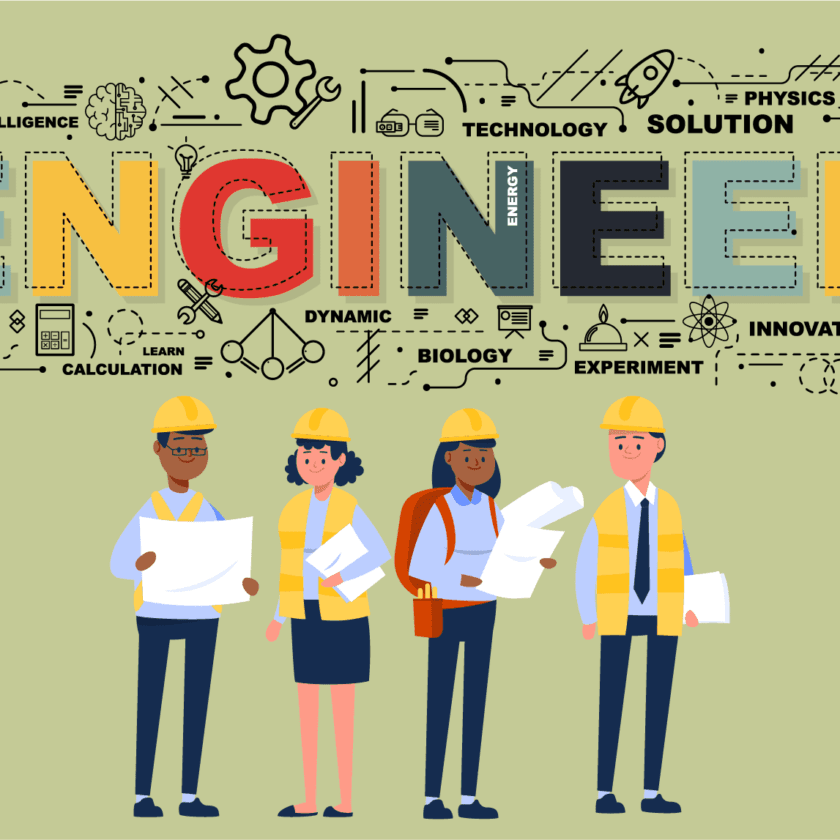engineering physics and mathematics principles
Mechanical engineering is an engineering discipline that combines engineering physics and mathematics principles with materials science to design, analyze, manufacture, and maintain mechanical systems. It is one of the oldest and broadest of the engineering disciplines.

Understanding of core areas including mechanics
The mechanical engineering field requires an understanding of core areas including mechanics, dynamics, thermodynamics, materials science, structural analysis, and electricity. In addition to these core principles, mechanical engineers use tools such as computer-aided design (CAD), computer-aided manufacturing (CAM), and product lifecycle management to design and analyze manufacturing plants, industrial equipment and machinery, heating and cooling systems, transport systems, aircraft, watercraft, robotics, medical devices, weapons, and others. It is the branch of engineering that involves the design, production, and operation of machinery.
The Industrial Revolution in Europe
Mechanical engineering emerged as a field during the Industrial Revolution in Europe in the 18th century; however, its development can be traced back several thousand years around the world. In the 19th century, developments in physics led to the development of mechanical engineering science. The field has continually evolved to incorporate advancements; today mechanical engineers are pursuing developments in such areas as composites, mechatronics, and nanotechnology. It also overlaps with aerospace engineering, metallurgical engineering, civil engineering, electrical engineering, manufacturing engineering, chemical engineering, industrial engineering, and other engineering disciplines to varying amounts. Mechanical engineers may also work in the field of biomedical engineering, specifically with biomechanics, transport phenomena, biomechatronics, bionanotechnology, and modelling of biological systems.
Various universities worldwide
Degrees in mechanical engineering are offered at various universities worldwide. Mechanical engineering programs typically take four to five years of study and result in a Bachelor of Engineering (B.Eng. or B.E.), Bachelor of Science (B.Sc. or B.S.), Bachelor of Science Engineering (B.Sc.Eng.), Bachelor of Technology (B.Tech.), Bachelor of Mechanical Engineering (B.M.E.), or Bachelor of Applied Science (B.A.Sc.) degree, in or with emphasis in mechanical engineering. In Spain, Portugal and most of South America, where neither B.S. nor B.Tech. programs have been adopted, the formal name for the degree is “Mechanical Engineer”, and the course work is based on five or six years of training. In Italy the course work is based on five years of education, and training, but in order to qualify as an Engineer one has to pass a state exam at the end of the course. In Greece, the coursework is based on a five-year curriculum and the requirement of a ‘Diploma’ Thesis, which upon completion a ‘Diploma’ is awarded rather than a B.Sc.
In the United States, most undergraduate mechanical engineering programs are accredited by the Accreditation Board for Engineering and Technology (ABET) to ensure similar course requirements and standards among universities. The ABET web site lists 302 accredited mechanical engineering programs as of 11 March 2014.[16] Mechanical engineering programs in Canada are accredited by the Canadian Engineering Accreditation Board (CEAB),[17] and most other countries offering engineering degrees have similar accreditation societies.
In Australia, mechanical engineering degrees are awarded as Bachelor of Engineering (Mechanical) or similar nomenclature, although there are an increasing number of specialisations. The degree takes four years of full-time study to achieve. To ensure quality in engineering degrees, Engineers Australia accredits engineering degrees awarded by Australian universities in accordance with the global Washington Accord. Before the degree can be awarded, the student must complete at least 3 months of on the job work experience in an engineering firm.[18] Similar systems are also present in South Africa and are overseen by the Engineering Council of South Africa (ECSA).
In India, to become an engineer, one needs to have an engineering degree like a B.Tech or B.E, have a diploma in engineering, or by completing a course in an engineering trade like fitter from the Industrial Training Institute (ITIs) to receive a “ITI Trade Certificate” and also pass the All India Trade Test (AITT) with an engineering trade conducted by the National Council of Vocational Training (NCVT) by which one is awarded a “National Trade Certificate”. A similar system is used in Nepal.[citation needed]
Some mechanical engineers go on to pursue a postgraduate degree such as a Master of Engineering, Master of Technology, Master of Science, Master of Engineering Management (M.Eng.Mgt. or M.E.M.), a Doctor of Philosophy in engineering (Eng.D. or Ph.D.) or an engineer’s degree. The master’s and engineer’s degrees may or may not include research. The Doctor of Philosophy includes a significant research component and is often viewed as the entry point to academia.[19] The Engineer’s degree exists at a few institutions at an intermediate level between the master’s degree and the doctorate.
Mechanical engineers research, design, develop, build, and test mechanical and thermal devices, including tools, engines, and machines.
Mechanical engineers typically do the following:
- Analyze problems to see how mechanical and thermal devices might help solve the problem.
- Design or redesign mechanical and thermal devices using analysis and computer-aided design.
- Develop and test prototypes of devices they design.
- Analyze the test results and change the design as needed.
- Oversee the manufacturing process for the device.
Mechanical engineers design and oversee the manufacturing of many products ranging from medical devices to new batteries. They also design power-producing machines such as electric generators, internal combustion engines, and steam and gas turbines as well as power-using machines, such as refrigeration and air-conditioning systems.
Like other engineers, mechanical engineers use computers to help create and analyze designs, run simulations and test how a machine is likely to work.
The field of mechanical engineering can be thought of as a collection of many mechanical engineering science disciplines. Several of these subdisciplines which are typically taught at the undergraduate level are listed below, with a brief explanation and the most common application of each. Some of these subdisciplines are unique to mechanical engineering, while others are a combination of mechanical engineering and one or more other disciplines. Most work that a mechanical engineer does uses skills and techniques from several of these subdisciplines, as well as specialized subdisciplines. Specialized subdisciplines, as used in this article, are more likely to be the subject of graduate studies or on-the-job training than undergraduate research. Several specialized subdisciplines are discussed in this section.
Mechanics
Mechanics is, in the most general sense, the study of forces and their effect upon matter. Typically, engineering mechanics is used to analyze and predict the acceleration and deformation (both elastic and plastic) of objects under known forces (also called loads) or stresses. Subdisciplines of mechanics include
Statics, the study of non-moving bodies under known loads, how forces affect static bodies
Dynamics the study of how forces affect moving bodies. Dynamics includes kinematics (about movement, velocity, and acceleration) and kinetics (about forces and resulting accelerations).
Mechanics of materials, the study of how different materials deform under various types of stress
Fluid mechanics, the study of how fluids react to forces Kinematics, the study of the motion of bodies (objects) and systems (groups of objects), while ignoring the forces that cause the motion. Kinematics is often used in the design and analysis of mechanisms.
Continuum mechanics, a method of applying mechanics that assumes that objects are continuous (rather than discrete)
Mechanical engineers typically use mechanics in the design or analysis phases of engineering. If the engineering project were the design of a vehicle, statics might be employed to design the frame of the vehicle, in order to evaluate where the stresses will be most intense. Dynamics might be used when designing the car’s engine, to evaluate the forces in the pistons and cams as the engine cycles. Mechanics of materials might be used to choose appropriate materials for the frame and engine. Fluid mechanics might be used to design a ventilation system for the vehicle (see HVAC), or to design the intake system for the engine.
Mechatronics and robotics
Mechatronics is a combination of mechanics and electronics. It is an interdisciplinary branch of mechanical engineering, electrical engineering and software engineering that is concerned with integrating electrical and mechanical engineering to create hybrid systems. In this way, machines can be automated through the use of electric motors, servo-mechanisms, and other electrical systems in conjunction with special software. A common example of a mechatronics system is a CD-ROM drive. Mechanical systems open and close the drive, spin the CD and move the laser, while an optical system reads the data on the CD and converts it to bits. Integrated software controls the process and communicates the contents of the CD to the computer.
Robotics is the application of mechatronics to create robots, which are often used in industry to perform tasks that are dangerous, unpleasant, or repetitive. These robots may be of any shape and size, but all are preprogrammed and interact physically with the world. To create a robot, an engineer typically employs kinematics (to determine the robot’s range of motion) and mechanics (to determine the stresses within the robot).
Robots are used extensively in industrial engineering. They allow businesses to save money on labor, perform tasks that are either too dangerous or too precise for humans to perform them economically, and to ensure better quality. Many companies employ assembly lines of robots, especially in Automotive Industries and some factories are so robotized that they can run by themselves. Outside the factory, robots have been employed in bomb disposal, space exploration, and many other fields. Robots are also sold for various residential applications, from recreation to domestic applications.
Thermodynamics and thermo-science
Thermodynamics is an applied science used in several branches of engineering, including mechanical and chemical engineering. At its simplest, thermodynamics is the study of energy, its use and transformation through a system. Typically, engineering thermodynamics is concerned with changing energy from one form to another. As an example, automotive engines convert chemical energy (enthalpy) from the fuel into heat, and then into mechanical work that eventually turns the wheels.
Thermodynamics principles are used by mechanical engineers in the fields of heat transfer, thermofluids, and energy conversion. Mechanical engineers use thermo-science to design engines and power plants, heating, ventilation, and air-conditioning (HVAC) systems, heat exchangers, heat sinks, radiators, refrigeration, insulation, and others.



